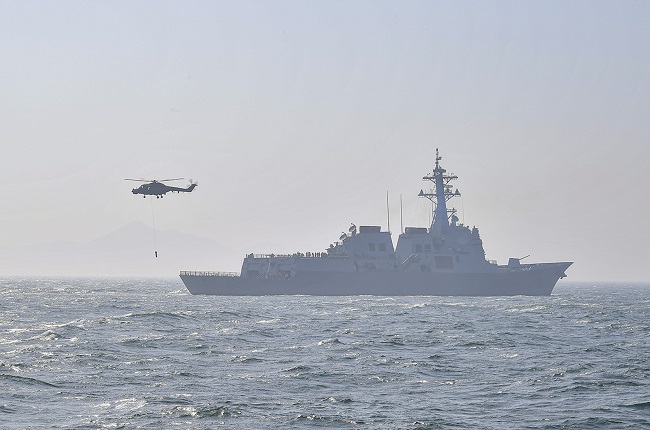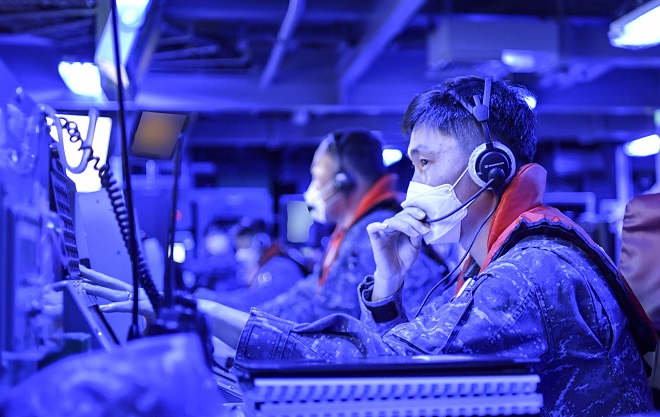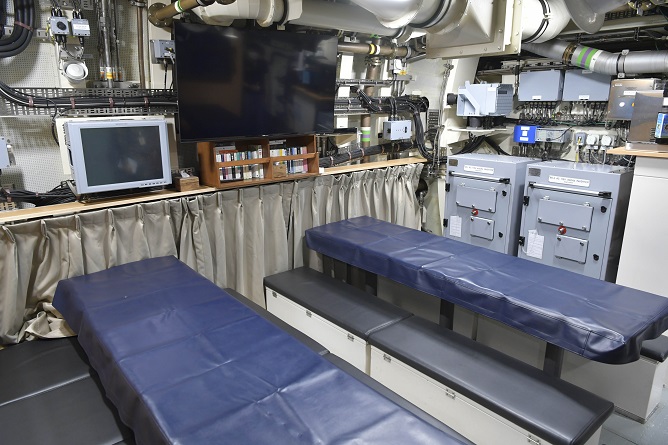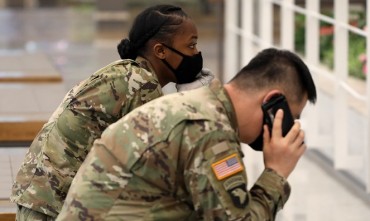
A Lynx maritime helicopter stages an anti-submarine exercise with the Sejong the Great destroyer in waters just south of Busan, 320 km southeast of Seoul, on May 16, 2023, in this photo released by the Navy on May 18.
BUSAN/CHANGWON, May 18 (Korea Bizwire) — A patrol aircraft emerged from heavy fog to drop sonar devices around a key guided-missile destroyer as part of South Korea’s Navy drills to track and destroy a simulated North Korean submarine.
A maritime helicopter then flew in close to the 7,600-ton Aegis-equipped warship, ROKS Sejong the Great, and descended a cable-linked sonar system into the waters off the country’s southeastern coast to pinpoint the enemy vessel.
In a vivid showcase of its combat readiness, the Navy gave the defense ministry’s press corps rare access to the highlight of the drills, including the anti-missile segment.
The drills came as tensions have run high due to North Korea’s menacing drive to develop new weapons, including “underwater nuclear attack drones,” as well as its plan to launch a long-range rocket disguised as a satellite.
The drills began with a ballistic missile defense segment that proceeded under the scenario of a North Korean submarine-launched ballistic missile (SLBM) being fired from waters off the east coast.
Inside the blue-lit combat command center of the destroyer, crew members detected an SLBM launch through the SPY-1D radar-based Aegis combat system capable of detecting targets 1,000 kilometers away and simultaneously tracking some 1,000 targets.
As the warship tracked the missile, it shared related data with the Air Force’s anti-ballistic missile command system overseeing interception operations, before the missile disappeared off the radar, presumably splashing into the East Sea.

Crew members of the Sejong the Great destroyer, sailing in waters just south of Busan, 320 km southeast of Seoul, take part in anti-submarine and missile defense drills inside the warship’s combat command center on May 16, 2023, in this photo released by the Navy on May 18.
The drills illustrated Seoul’s renewed focus on sharpening its missile detection and tracking capabilities in the wake of Pyongyang’s missile tests earlier this year, including a purported solid-fuel intercontinental ballistic missile launch last month.
Along with two other Aegis destroyers of the Navy, the advanced warship plays a key role in the Korea Air and Missile Defense, a pillar of Seoul’s three-axis defense system, which also consists of the Kill Chain preemptive strike platform, and the Korea Massive Punishment and Retaliation, an operational plan to incapacitate the North Korean leadership in a major conflict.
To further bolster the three-pronged system, the country is building the next-generation 8,200-ton Jeongjo the Great destroyer to be equipped with a missile interception system, which the country’s current Aegis warships do not have.
The new destroyer is expected to be delivered to the Navy late next year.
Following the missile defense drills, crew members trained under the scenario of a simulated North Korean submarine attack.
The Sejong the Great made an emergency maneuver to evade a torpedo attack and fired an anti-submarine missile from one of its 128 vertical launch cells to sink the enemy vessel.
Joining the destroyer in the drills were the P3 patrol plane and the Lynx chopper that deployed the sonar devices used to locate enemy submarines into waters near the destroyer.
The North’s testing of underwater nuclear attack drones in March and last month was yet another stern reminder of its growing maritime threats.
It is known to possess some 70 conventional submarines, whereas the South has around 10 submarines — apparently more advanced than the North Korean subsurface platforms.
“In preparation against various enemy threats, the Sejong the Great is maintaining the highest combat readiness posture through high-intensity and realistic training,” Capt. Kim Sung-phil, commander of the warship, told reporters.

The mess hall of the 3,000-ton Dosan Ahn Changho submarine is shown in this photo provided by the Navy on May 18, 2023.
On Wednesday, the Navy gave a press tour of the 3,000-ton ROKS Dosan Ahn Changho submarine docked at the Submarine Force Command at a key naval base in Changwon, about 300 km southeast of Seoul, for the first time.
The vessel began operations last August.
The country’s first KSS-III Batch-I submarine is a key asset for the three-axis system, given its SLBM capability, which allows the vessel to launch surprise attacks in a contingency.
The vessel carrying around 50 personnel is known to have six vertical missile launch cells for SLBMs and is much larger than the country’s previous 1,800-ton submarine platform.
“For submarine units, peacetime is identical to wartime,” Rear Adm. Lee Su-youl, the commander of the Submarine Force, said, citing the vessels’ covert operations.
“We plan, train and maintain our readiness by thinking that we are at wartime at all times.”
The country plans to operate three KSS-III Batch-I submarines, with the second one being delivered to the Navy last month and the third one to be delivered sometime next year.
(Yonhap)






